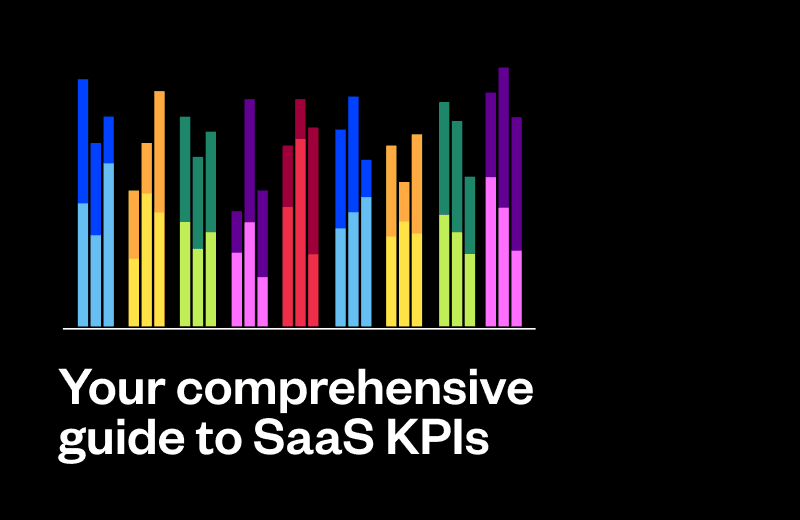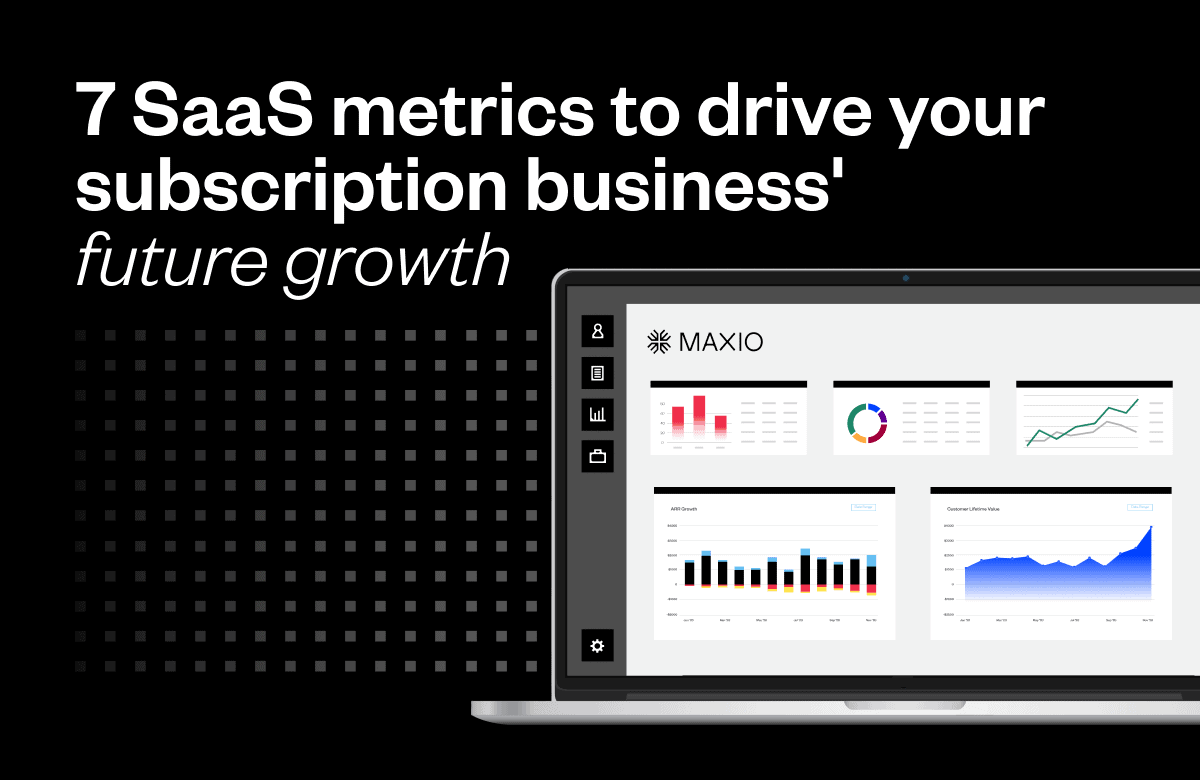Whether you’re raising your first institutional round of funding or you’re looking to retain funding from an investor, there are specific revenue growth metrics and KPIs that investors expect their portfolios to produce. Not only do these metrics help support the story you’re telling investors about the business, but they are the cornerstone of key operational insights that can help drive your business forward. In today’s landscape, investors are taking a closer look at their portfolio companies to ensure their sustainability and strategize ways to help them grow—even in times of economic downturn. That’s why we partnered with Fulcrum Equity Partners to create a comprehensive guide to SaaS KPIs and important metrics like churn, MRR, ARR, lead generation, and upsell revenue.
“Tracking these metrics provides a really insightful view of a company’s business model, sales efficiency, and customer validation. Ultimately, it delivers investors with the key information needed to build conviction during a fundraising process.”
-Chad Hooker, VP, Fulcrum Equity Partners
What is a typical revenue growth rate for SaaS companies?
When you sit down to review your company metrics with your investors and the board, you’ll typically be faced with questions regarding new bookings, churn, and cash burn. These leading and lagging indicators allow them to track progress of your company’s performance quarter-over-quarter.
However, what investors really care about is your company’s revenue growth rate. How does the current period’s revenue compare to the previous period’s revenue? How are repeat customers and customer retention factored in? How much of what your company brings in is the result of sales revenue vs. upsells and cross-sells from your CS team?
In order to gauge your own company’s performance vs. similar SaaS companies in your vertical or revenue range, you’ll need accurate benchmarking metrics. The 2022 OpenView SaaS Benchmarks Survey breaks down the median SaaS revenue growth rate as follows:
<$1M: 100% (46-286%)
$1-2.5M: 79% (37-153%)
$2.5-10M: 50% (30-115%)
$10-20M: 72% (30-101%)
$20-50M: 40% (30-52%)
>$50M: 30% (18-55%)
[IMAGE]
How to calculate your revenue growth rate
To accurately benchmark your revenue growth rate, you’ll need to make sure you’re calculating the metric appropriately. Here are the steps you can take to calculate your revenue growth rate and see if your company is heading in the right direction:
1. Determine the time period: Decide on the time period for which you want to calculate your revenue growth rate. It could be monthly, quarterly, or annually, depending on what your board and investors want to see.
2. Gather the revenue data: Collect the revenue data for the chosen time period. This can be obtained from your financial statements, such as income statements or profit and loss statements. You can also pull this data directly from a SaaS metrics platform like Maxio.
3. Calculate the revenue growth: To calculate your revenue growth rate, use the following formula.

- Subtract your previous revenue from the current revenue in the specified period (monthly, quarterly, yearly)
- Divide the result by your previous revenue
- Multiply the quotient by 100 to express the growth rate as a percentage
For example, if your previous revenue was $100,000 and your current revenue is $150,000, the calculation would be:

4. Interpret the result: Once you’ve calculated your revenue growth rate, interpret the result to gain insights into your business’s performance. A positive growth rate indicates your revenue is increasing, while a negative growth rate suggests a decline in revenue. The magnitude of the growth rate reflects the pace of revenue growth.
5. Analyze and adjust: You can use your revenue growth rate as a key performance indicator to evaluate your business’s performance over time. Compare it with SaaS industry averages or your own historical data to identify trends and patterns. If the growth rate is lower than desired, consider implementing strategies to boost revenue, such as expanding your customer base, launching new products or services, or improving marketing efforts.
6. Consider your business model: If your company makes use of subscription-based services, it is important to factor in the churn rate of your customer base. Churn rate refers to the percentage of customers who cancel their subscription within a given time period. Reducing churn can lead to more revenue and a higher revenue growth rate.
7. Track conversion rates: To increase revenue growth, it’s important to track conversion rates—the percentage of potential customers who become paying customers. By improving conversion rates, you can increase your customer base and ultimately generate more revenue.
8. Focus on total revenue: While your revenue growth rate is an important metric, it’s important to also focus on total revenue. A high growth rate may be impressive, but if the total revenue is low, it may not be sustainable in the long run.
By regularly calculating and analyzing your revenue growth rate, you can make informed decisions and take proactive steps to drive the success of your business.
Now that you highlighted the importance of your revenue growth rate, let’s take a look at the other revenue growth metrics that matter to your investors.
Insights from investors: revenue growth metrics
Revenue growth performance metrics provide visibility into the health of your business and its growth potential. You’re likely familiar with these, but we’ll recap what they are just in case.
Foundational metrics you should know:
- ARR and MRR
- ACV
- CAC, CLV, and CAC Payback
ARR or MRR
Annual Recurring Revenue (ARR) or Monthly Recurring Revenue (MRR) is the value of the contracted recurring revenue components of your term subscriptions normalized to an annual or one-month period. While an MRR/ARR number is important, it’s the momentum categories that provide true insight. In Maxio’s Subscription Momentum reports, we break ARR/MRR down into the following categories:
- New ARR/MRR: new sales to new customers
- Expansion ARR/MRR: existing customers who expanded their subscriptions or licensed additional products or modules
- Contracted ARR/MRR: existing customers who downgraded their subscription and/or reduced their consumption
- Canceled ARR/MRR: existing customers who canceled their subscription. These components are frequently measured in both absolute value and relative value and are often presented in the context of incremental changes from period to period
The investor’s point of view on ARR or MRR
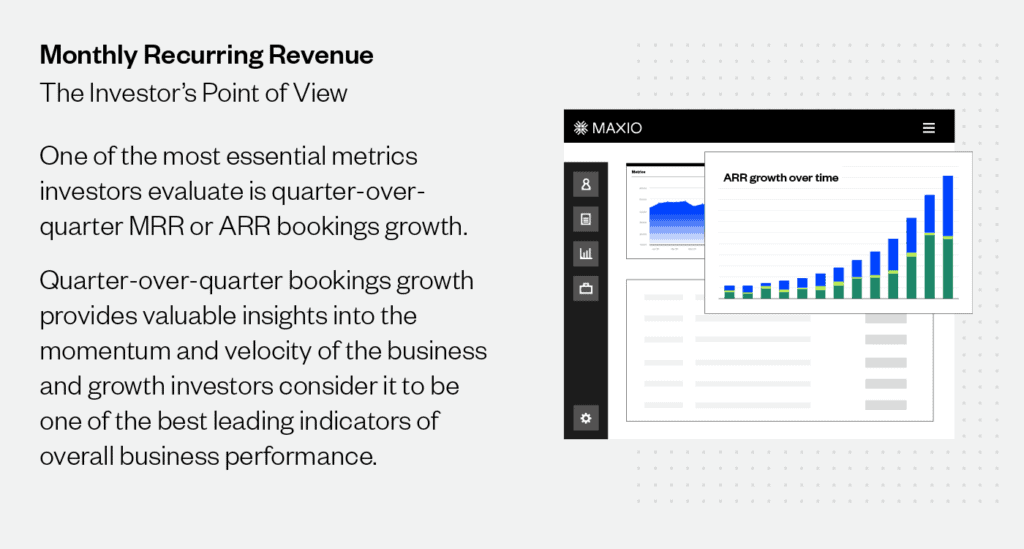
One of the most essential metrics investors evaluate is quarter-over-quarter ARR or MRR bookings growth.
Quarter-over-quarter bookings growth provides valuable insights into the momentum and velocity of the business. Investors consider it to be one of the leading indicators of overall business performance.
Average Contract Value
Average Contract Value (ACV) is a measure of the average revenue generated per customer and is usually calculated annually.
A growing or contracting ACV is a good indicator of the value you’re providing customers.
This metric is also a critical input for your sales and marketing plan and provides visibility into how many leads (MQLs) and opportunities (SQLs) are needed to achieve your plan.
The investor’s point of view on Average Contract Value
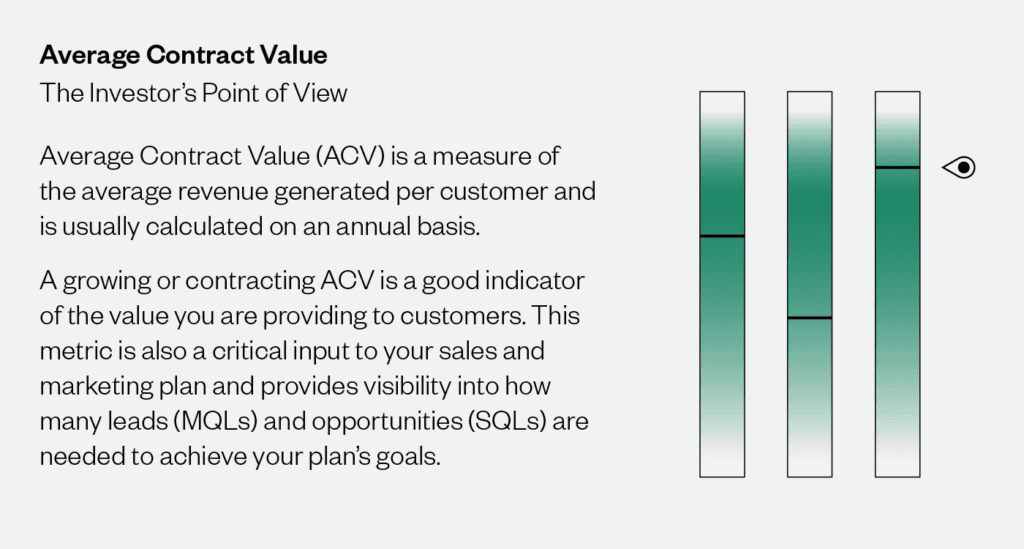
Tracking ACV over time is valuable to understand evolving customer behaviors. It helps drive decision-making for sales and marketing, customer success and retention, as well as your product roadmap.
ACV is also a useful metric to measure the success of land-and-expand growth strategies, upsell initiatives, and a company’s ability to deliver value to customers continually.
Customer Acquisition Cost
Customer Acquisition Cost, or “CAC,” helps you make important decisions about allocating sales and marketing spend. It’s valuable in understanding how much your company is making from each new customer.
In essence, these metrics measure how long it takes to surpass the money you spent to acquire that customer.
- Customer Acquisition Cost (CAC): the total sales and marketing resources associated with acquiring a new customer
- Customer Lifetime Value (CLV): the average revenue or profit a customer will generate before they churn
- CAC Payback: the time it takes (in months) to recoup the cost of acquiring a new customer.
Note: Calculating CAC can be a very nuanced effort. Depending upon how your business is structured, automatically including all sales and marketing costs in the month they appear can be misleading. We recommend a thoughtful approach here. Start by asking the question, “Is this truly a cost associated with acquiring a new customer, and is this the correct time period for this expense?”
You can also measure your CLV against CAC, commonly known as your CLV/CAC ratio, to determine what you can expect to net for every dollar you spend to acquire a customer.
The investor’s point of view on customer acquisition costs
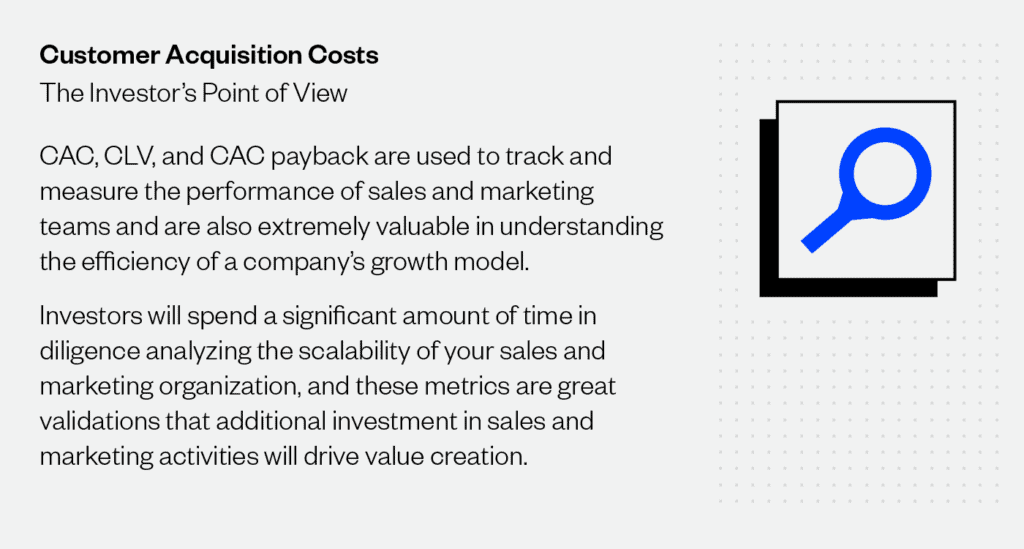
CAC, CLV, and CAC Payback are used to measure the performance of sales and marketing teams and are also extremely valuable in understanding the efficiency of a company’s growth model.
Investors will spend a significant amount of time in due diligence, analyzing the scalability of your sales and marketing organization. These metrics are great validations that additional investment in sales and marketing activities will drive value creation.
Get Your Free SaaS Metrics Template
Template provides you with a comprehensive set of pre-built SaaS metrics (that you can trust) to wow investors and make key business decisions with confidence.
Increasing revenue and pleasing investors: final thoughts
What’s the best way for SaaS leaders to increase their revenue and please investors? The answer is simple: provide more value to customers. By doubling down on customer satisfaction, you’re essentially knocking out two birds with one stone.
At Maxio, we’ve built a platform to help you do just that. Our SaaS metrics and analytics dashboard helps you see how product lines and business segments are performing across your customer base. You can then use that knowledge to pull the right growth levers in your business, increase revenue, and ultimately get buy-in from investors on your next stage of growth.
If you found the additional context provided around these revenue growth metrics helpful, check out our e-guide to see the full list of KPIs and insights from the investors at Fulcrum Equity Partners.

